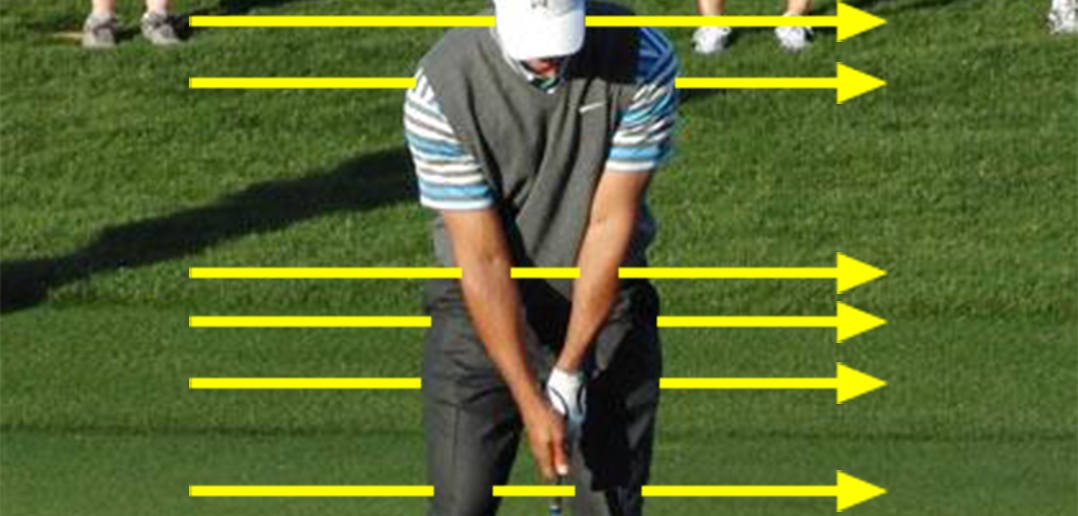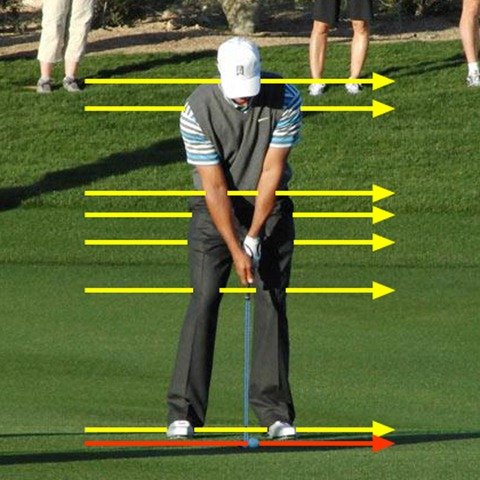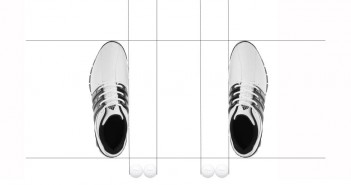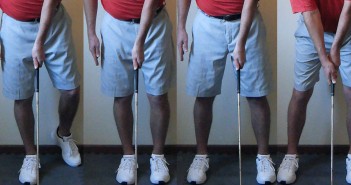Hitting the ball where you want it to go is obviously the most important part of playing a successful golf shot. To do that consistently you need to pick a target carefully, and then setup correctly to give yourself the best chance of hitting the golf shot. That’s pretty basic stuff, but few amateur golfers make the effort to do it correctly.
Aim and alignment are two different but closely related things. Aim is deciding exactly where you want the golf ball to go, picking a target. Alignment is setting up correctly to play the golf shot that will have the best chance of sending the ball to that target.
Alignment is more important than aim. If you can’t hit the ball straight, then it will rarely go where you want it to, no matter how good your aim is. This is why most amateur golfers don’t really make the effort — if you’re spraying the ball all over the place, why bother with a pre-shot routine? Well, if you want to improve as a golfer, you need to work on integrating both aim and alignment into a good pre-shot routine, which will actually improve your golf swing, they go hand in hand.
Once again, apologies to the lefties, for simplicity these instructions are given for a right-handed golfer.
Summary
- Start from behind the ball.
- Carefully choose a precise target.
- Pick an intermediate target.
- Visualise the ball flight.
- Be decisive.
- Step into the shot from behind the ball and point the club face precisely at your intermediate target, then align your eyes.
- Finally, align your feet, knees, thighs, hips, arms, and shoulders parallel to the target line.
What Are You Aiming At?
Carefully selecting your target should form part of your pre-shot routine for every golf shot.
Most amateur golfers don’t have a pre-shot routine, as such, and even if they have, they don’t always follow it. All great golfers have a pre-shot routine that they follow religiously. Routines may seem dull and repetitive, but golf is a lot more fun if you play better shots and shoot lower scores!
A good pre-shot routine should get you mentally and physically prepared to play a good golf shot. We’ll discuss the mental and strategic aspects of this in more detail in other articles, but we touched on it in How to Learn a Great Golf Swing, where we described the two parts of your brain, The Player and The Learner. To play a great golf shot, you need to set up to the ball, switch off, let go, and just play the shot — to let The Player do his thing. To do that successfully, you first need to satisfy The Learner, let him decide what shot to play, so that he will be able to let go, relax and give The Player a chance. This is an important part of what a pre-shot routine is for.
To begin with, you should consider your target as the spot where you want the ball to land, or pitch. In choosing a spot to pitch the ball, you will take into consideration where you expect it will bounce and roll to afterwards.
Your pre-shot routine should start from behind the ball, looking towards the target.
You have already had a look at the lie of the golf ball. Is it sitting nicely in the fairway, or in the rough? If in the rough, how thick is it? Can you get the club on the back of the ball? Is your swing restricted? What is your stance like? Is it an uphill or downhill lie? Is the ball above or below your feet? You have a good idea what shots might be more difficult to play.
Welcome to the Practice Zone
Draw an imaginary line 2 yards (2m) behind the ball and stand behind it. When you’re behind the line, you’re in the Practice Zone, and The Learner is in charge. When you step over that line, you’re in the Performance Zone, and you need to let The Player take over, don’t think, just set up to the ball and hit the shot. When you are working on your swing, this is really difficult to do — you can’t think about your grip or spine angle and be The Player at the same time — which is why you need to work hard on the drills presented here in the Swing like a Champion system, to ingrain the correct movements and positions, before you step onto a golf course.
Thinking activates The Learner, as does doubt, anxiety and vigilance. When active, The Learner will greedily use up all of your attention, leaving no room for The Player. The Learner is a terrible golfer!
In the Practice Zone, look at the hole in front of you. Where would be a good place to pitch the ball? Where don’t you want the ball to go? An important part of playing good golf is knowing where not to miss.
Consider the distance to your potential target, the pin position, where the danger areas are, the wind direction, and the topography — is it uphill or downhill, or on a side slope, how will the ball bounce and roll after it pitches?
Know your own limitations, what might your bad shot do? Are you struggling to play your usual shot shape today? Don’t be afraid to play conservatively, within yourself. Consider the worst case, allow for it, and then cast it from your mind.
Decide what shot you want to play, how you want to flight the ball, and pick a target area. A region where pitching the ball, with a shot that you can reasonably expect to make, will be successful. Never pick a target where a good shot might leave you in trouble.
Now pick a precise spot that, if you hit the ball towards it with your chosen shot, you would expect the ball to pitch in the middle of your target region. For example, if you expect the wind to make the ball pitch 10 yards (9m) to the left of the centre of your target area, then the spot will be 10 yards (9m) to the right.
Pick a fixed feature that is exactly in line with your target. This could be a tree trunk, a stripe on the fairway, or some other fixed feature on the course. It can be in the far distance, it doesn’t matter, it’s something you are going to line up with.
This feature is now the target for your golf swing.
Prepare to Perform
Pick the right club for your chosen shot, and visualise the shot. See the ball flight in your minds eye, see it pitch and roll out to exactly where you want it.
Take your left hand grip on the selected club. Hold it up in front of you, in line with the ball and the target (the target line). With the help of the club, pick a mark on the target line, an intermediate target, about 1 or 2 yards (1-2m) ahead of the ball, something small but easy to see, such as a pitch mark or a discolouration in the grass. It needs to be far enough in front of the ball to enable you to accurately visualise the target line, and not be distorted if your dominant eye is behind the ball, but close enough so that you can see it clearly in your peripheral vision without turning your head away from square.
Visualise the shot once more, cast aside any doubts. The target you have chosen is all there is. That trouble on the left doesn’t exist, you’ve taken it out of play with your shot selection. It’s easier said than done, but thinking about what might go wrong at this stage can’t possibly help you, and thinking or anxiety will bring The Learner to the fore, smother The Player, and ruin your golf swing.
Be completely decisive, and step over into the Performance Zone, approaching from behind the ball. Line up with your intermediate target and make a nice, smooth golf swing, everything else is taken care of.
You will use your intermediate target for alignment, but when you have taken your stance, and you are about to make your swing, you should be very aware of the target itself. Glance over to it a couple of times and fix the precise spot in your mind’s eye, The Player (your inner athlete) will “react” to the target as you make your swing.
When you are playing a straight shot, a good thought to have is to send the golf ball directly over your intermediate target.
Isn’t a Straight Golf Shot the Most Difficult to Play?
You may have heard that the perfectly straight shot is the most difficult to play.
Yes, generally speaking, it’s easier to hit a fade or a draw than it is to hit it straight. But when we talk about precision, this isn’t the case.
How much, precisely, will your fade or draw curve through the air? Exactly how much spin will you put on the ball? How far will the ball kick left or right when it pitches?
A straight shot is no more difficult to play than a controlled 5-yard (5m) draw, or a 6-yard (6m) fade.
Some great ball strikers have aimed a little right and pulled their shots, or aimed left and pushed them, but for maximum efficiency, simplicity, and flexibility, we want you to set up square.
With the Swing like a Champion system, we will start by teaching you how to hit the ball straight, and then build from there if you want to learn how to shape your shots.
For the sake of this discussion, we’ll assume you’re playing a straight shot.
Alignment
The usual analogy used to teach golf alignment is the railroad tracks, and it’s a good one. Your feet are aligned on the inside rail. The club head, the golf ball, your chosen intermediate target, and the target are on the outside rail, which is the target line.
We mention the feet here because it is easy to align your feet parallel to the target line first, and then to square your body.
Your alignment starts, however, with your club face — aligning your body perfectly won’t help you to hit the ball straight if your club face isn’t square at impact — the angle of your club face at impact has a much stronger influence on the golf ball’s direction than does your swing path, as we’ll discuss in other articles. We strongly recommend that you step up to the golf ball having already taken your left hand grip, your left hand is primarily responsible for the face angle at impact, and then use the club face as your starting point for your alignment.
Use your intermediate target to help you visualise the target line on the ground. As you step into position from behind the ball, point the club face at your intermediate target, align your eyes, and then align your body parallel to the target line.
You should actually have your eyes, feet, knees, thighs, hips, arms, and shoulders, but most of all the club face, all aligned parallel to the target line (each on their own “rail”) — see Figure 1.
Figure 1. Align your body (yellow lines) parallel to the target line (red line).
Of these, after the club face, your eyes and shoulders are the most important. They have the most effect on your swing path, the location of the bottom of your swing arc, and on squaring the club face at impact.
Never be tempted to turn any part your body to face the golf ball. Look at the ball, but don’t turn your head towards it, keep your eyes parallel to the target line.
As you address the ball, you’ll turn your head to look at your intermediate target and the actual target, but be sure to square your eyes again before you make your swing.
For example, if your eyes or shoulders are aligned slightly to the right of the target, this can cause you to take the club back too much to the inside in your backswing, which can make your swing too steep, causing you to hit it fat (hit the ground behind the ball), or to come over the top in an attempt to compensate.
Aligning your eyes to the right of the target often makes you swing too much from the inside, causing a push hook. Too far left may cause a pull slice.
Likewise tilting your head can cause similar problems, causing your swing plane to be too steep or too flat, and hitting the ball fat or thin, as well as making it more difficult to stay in balance during your golf swing. Your head will tilt slightly as you tilt your spine at address, it needs to in order to keep your neck in good posture, but you should try to keep your eyes reasonably level during your golf swing, as much as you can without restricting your backswing.
Feet Parallel
We recommend that your toes and knees should be pointing forward, your feet parallel to each other, with your toes and heels parallel to the target line.
If you suffer from restricted hip mobility, then you can turn your left foot out slightly, at most 30 degrees, which will help you to turn into the follow-through while still in balance.
You should never turn your right foot out. You may have been told that this will help you make a full turn on the backswing, but helping the hips to turn more is counterproductive — much of your power will come from the separation between your hips and shoulders during the backswing, which we’ll discuss in detail in later articles.
If you do decide to turn your left foot out, then do it after you have addressed the ball and aligned your body, and make sure that your heels remain parallel with the target line.
If you have any questions or comments about this or other articles on Golf Loopy, please send us an email.
Next up: We describe a great way to address the golf ball with perfect alignment and posture, every time, in Golf Swing Drill 108 – Setup: Addressing the Golf Ball.





